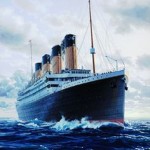 Back in 1912, there was no such thing as social media. These days, whenever something happens, people armed with their camera phones are quick to whip them out and record video or take photos of the incident. In the days before social media, people who were witnesses to disaster, often spoke to the media, who then would recreate whatever was described in drawings. Some of the drawings that were created after the Titanic sank were truly terrifying, so scary in fact that survivors of the disaster said they brought back terrifying memories of a night they will never forget. Here are some drawings from 1912 that still inspire fear over 100 years after the Titanic sank.
Back in 1912, there was no such thing as social media. These days, whenever something happens, people armed with their camera phones are quick to whip them out and record video or take photos of the incident. In the days before social media, people who were witnesses to disaster, often spoke to the media, who then would recreate whatever was described in drawings. Some of the drawings that were created after the Titanic sank were truly terrifying, so scary in fact that survivors of the disaster said they brought back terrifying memories of a night they will never forget. Here are some drawings from 1912 that still inspire fear over 100 years after the Titanic sank.
1. Drawing of the Lifeboats Being Lowered
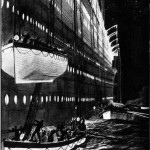 The night the Titanic struck an iceberg and sank, there was very little time to launch the lifeboats. Thomas Andrews, the designer of the ship, told Captain Smith that if they were lucky, they had maybe two hours before the ship sank. This drawing depicts the great ship lowering the lifeboats from the top deck to the water, which survivors described as being quite terrifying. One look at this eerie drawing and it does inspire one to shiver, not only becuase of the cold air, but the whole situation had to be terrifying on many levels.
The night the Titanic struck an iceberg and sank, there was very little time to launch the lifeboats. Thomas Andrews, the designer of the ship, told Captain Smith that if they were lucky, they had maybe two hours before the ship sank. This drawing depicts the great ship lowering the lifeboats from the top deck to the water, which survivors described as being quite terrifying. One look at this eerie drawing and it does inspire one to shiver, not only becuase of the cold air, but the whole situation had to be terrifying on many levels.
2. A Cross Section of the Bow At the Time of the Iceberg Collision
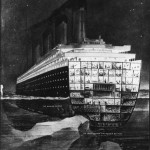 There was no such things as news broadcasts back in 1912, so only people who were directly involved with the construction of Titanic knew just how big she was, and the way she looked. While there was at least one magazine that featured the Titanic, not everyone had access to these publications. Another drawing that came out when the Titanic sunk had a depiction of a cross section of her bow, to give folks and idea of just how big she was, and what she had in each level of her. The drawing also showed just what the collision with the iceberg did to her hull, which was buckling plates and popping rivets.
There was no such things as news broadcasts back in 1912, so only people who were directly involved with the construction of Titanic knew just how big she was, and the way she looked. While there was at least one magazine that featured the Titanic, not everyone had access to these publications. Another drawing that came out when the Titanic sunk had a depiction of a cross section of her bow, to give folks and idea of just how big she was, and what she had in each level of her. The drawing also showed just what the collision with the iceberg did to her hull, which was buckling plates and popping rivets.
3. The Collision with the Iceberg
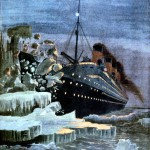 At the time the time the Titanic sank, some details were misrepresented, or were just plain wrong. However, one has to remember that in those days, the more sensational the story, the more newspapers that were sold. This drawing shows the Titanic striking the iceberg head on, which did not happen, and there was once a lot of speculation that if the ship had struck that way that no one would have died, but that was later proven to be an incorrect theory. One look at this drawing does seem rather terrifying, the ship plowing head first into a huge iceberg, and the bits of ice flying everywhere, does seem rather impressive, though it is completely incorrect.
At the time the time the Titanic sank, some details were misrepresented, or were just plain wrong. However, one has to remember that in those days, the more sensational the story, the more newspapers that were sold. This drawing shows the Titanic striking the iceberg head on, which did not happen, and there was once a lot of speculation that if the ship had struck that way that no one would have died, but that was later proven to be an incorrect theory. One look at this drawing does seem rather terrifying, the ship plowing head first into a huge iceberg, and the bits of ice flying everywhere, does seem rather impressive, though it is completely incorrect.
4. The Rescue of the Survivors
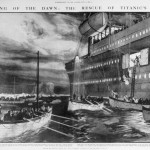 The 705 people who were in the Titanic’s 20 lifeboats, were in the water waiting for rescue all the way up until about 4 o’clock in the morning. Around that time, the rescue ship Carpathia showed up and began picking up all the survivors. Because there were so many lifeboats, it took the Carpathia around 4 hours for everyone to be brought on board. This drawing shows the lifeboats coming to the ship, and then the crew from it bringing everyone on board. The picture may be more eerily accurate than the artist knows becuase this is exactly what happened when the survivors made their way to the warm and safety of the Carpathia. This drawing is very accurate, and many survivors did talk about how grateful they were to see both the dawn and the ship that would take them to New York City.
The 705 people who were in the Titanic’s 20 lifeboats, were in the water waiting for rescue all the way up until about 4 o’clock in the morning. Around that time, the rescue ship Carpathia showed up and began picking up all the survivors. Because there were so many lifeboats, it took the Carpathia around 4 hours for everyone to be brought on board. This drawing shows the lifeboats coming to the ship, and then the crew from it bringing everyone on board. The picture may be more eerily accurate than the artist knows becuase this is exactly what happened when the survivors made their way to the warm and safety of the Carpathia. This drawing is very accurate, and many survivors did talk about how grateful they were to see both the dawn and the ship that would take them to New York City.
In the next post, at this time next week, there are 5 more really scary, yet accurate, drawings that the public were first introduced to when the might ship, the RMS Titanic slid below the waters of the North Atlantic on April the 15, 1912. The Titanic sank almost 104 years ago, but the ship, her story, and her passengers, are always in the news in one way or another. Despite sinking so long ago, the public just can never get enough of the story of this once magnificent ship that sunk one cold April night in 1912.

